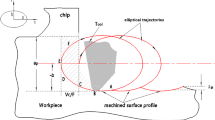Abstract
As an advanced cutting method, ultrasonic elliptical vibration cutting (UEVC) has been successfully applied to machine difficult-to-cut materials for the last decade. However, few researches have been studied on cutting of Inconel 718 using a single-point diamond tool applying the UEVC method. The objective of this paper was to experimentally derive empirical equations for the prediction of multiple machined surface roughness parameters for UEVC machined Inconel 718 workpiece by means of a systematic statistical experimental approach. A Taguchi parametric screening design of experiments (DOE) was carried out to systematically determine the UEVC process parameters with the largest effect on mean surface roughness. Next, empirically determined equations for the four common surface roughness metrics (Ra, Rq, Rc, and Rz) were developed via Box-Behnken surface response tests. Validation tests were conducted resulting in predicted and experimental surface roughness in varying levels of agreement. The ultrasonic effect on surface quality was also discussed to confirm feasibility of UEVC of Inconel 718 with diamond cutting tools.
Similar content being viewed by others
References
Thakur D, Ramamoorthy B, Vijayaraghavan L (2009) A study on theparameters in high-speed turning of superalloy Inconel 718. Mater Manuf Process 24(4):497–503
Zhou J, Bushlya V, Avdovic P, Ståhl JE (2012) Study of surface quality in high speed turning of Inconel 718 with uncoated and coated CBN tools. Int J Adv Manuf Technol 58(1–4):141–151
Bhaduri D, Soo SL, Novovic D, Aspinwall DK, Harden P, Waterhouse C, Bohr S, Mathieson AC, Lucas M (2013) Ultrasonic assisted creep feed grinding of Inconel 718. Procedia CIRP 6:616–621
Hsu C, Huang C, Wu C (2007) Milling of MAR-M247 nickel-based superalloy with high temperature and ultrasonic aiding. Int J Adv Manuf Technol 34(9–10):857–866
Baghlani V, Mehbudi P, Akbari J, Sohrabi M (2013) Ultrasonic assisted deep drilling of Inconel 738LC superalloy. Procedia CIRP 6:572–577
Lin S, Chung C, Cheng Y (2011) Combination of ultrasonic vibration and cryogenic cooling for cutting performance improvement of Inconel 718 turning. AIP Conference Proceedings. 1163, 1163–1168
Nath C, Rahman M (2008) Effect of machining parameters in ultrasonic vibration cutting. International Journal of Machine Tools & Manufacture 48:965–974
Tsao CC, Chen CC, Chen GC, Chueh CA, Qiu YX, Hsu CY (2012) Ultrasonic-assisted on the turning of Inconel 718 by taguchi method. Adv Mater Res 579:160–173
Mitrofanov A, Ahmed N, Babitsky V, Silberschmidt V (2004) Finite element analysis of ultrasonically assisted turning of Inconel 718. J Mater Process Technol 153:233–239
Mitrofanov A, Ahmed N, Babitsky V, Silberschmidt V (2005) Effect of lubrication and cutting parameters on ultrasonically assisted turning of Inconel 718. J Mater Process Technol 162-163:649–654
Feyzi, T; Safavi, S M. Improving machinability of Inconel 718 with a new hybrid machining technique. Int J Adv Manuf Technol 2013, 66(5–8), 1025–1030.
Ahmed N, Mitrofanov A, Babitsky V, Silberschmidt V (2006) Analysis of material response to ultrasonic vibration loading in turning Inconel 718. Mater Sci Eng A 424(1):318–325
Maurotto A, Muhammad R, Roy A, Babitsky V, Silberschmidt V (2012) Comparing machinability of Ti-15-3-3-3 and Ni-625 alloys in UAT. Procedia CIRP 1:330–335
Amini S, Soleimanimehr H, Nategh M, Abudollah A, Sadeghi M (2008) FEM analysis of ultrasonic-vibration-assisted turning and the vibratory tool. J Mater Process Technol 201(1):43–47
Muhammad R, Ahmed N, Roy A, Silberschmidt VV (2012) Turning of advanced alloys with vibrating cutting tool. Solid State Phenom 188:277–284
Shamoto E, Moriwaki T (1999) Ultraprecision diamond cuttingof hardened steel by applying elliptical vibration cutting. CIRPAnnals—Manufacturing Technology 48(1):441–444
Volkov GA, Bratov VA, Gruzdkov AA, Babitsky VI, Petrov YV, Silberschmidt VV (2011) Energy-based analysis of ultrasonically assisted turning. Shock Vib 18(1–2):333–341
Guiying DONG, Yuanliang ZHANG (2012) Design of the ultrasonic vibration cutting tool. Machinery Design & Manufacture 2:242–244
DeMeo M, Laget M, Mathieu D (1985) Application of experimental designs for optimization of medium and culture conditions in fermentation. Bioscience 4:99–102
Rama P, Reddy M, Reddy G (1999) Production of thermostable pullulanase by Clostridium thermosulfurogenes SV2 in solid-state fermentation: optimization of nutrients levels using response surface methodology. Bioprocess Eng 21:497–503
Annadurai G (2000) Design of optimum response surface experiments for adsorption of direct dye on chitosan. Bioprocess Eng 23:451–455
Ester RG, Alvaro BN, Alberto CBJ (2001) Optimisation of medium composition for clavulanic acid production by Streptomyces clavuligerus. Biotechnol Lett 23:157–161
Constantinos E. Efstathiou. Estimation of type I error probability from experimental Dixon’s “Q” parameter on testing for outliers within small size data sets. Talanta, 2006, 69:1068–1071.
Gerhard J.A. Schneider. Dixon’s character table algorithm revisited. J Symb Comput, 1990, 9(5): 601–606.
Author information
Authors and Affiliations
Corresponding author
Rights and permissions
About this article
Cite this article
Haidong, Z., Shuguang, L., Ping, Z. et al. Process modeling study of the ultrasonic elliptical vibration cutting of Inconel 718. Int J Adv Manuf Technol 92, 2055–2068 (2017). https://doi.org/10.1007/s00170-017-0266-5
Received:
Accepted:
Published:
Issue Date:
DOI: https://doi.org/10.1007/s00170-017-0266-5




